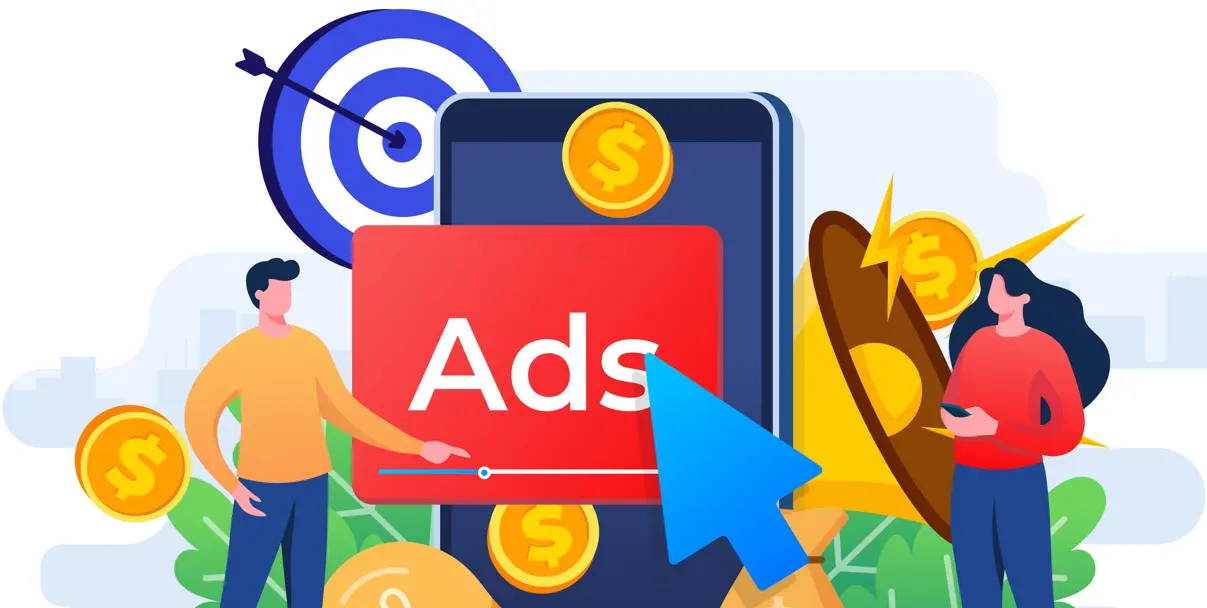Whether you’re looking to increase brand awareness, drive website traffic, generate leads, or boost online sales, choosing the right Google Ads campaign type is essential.
Therefore, in this guide, we’ll explore:
- The different types of Google Ads campaigns available in 2025.
- How to determine which campaign is best suited for your goals.
By the end, you’ll have a clear understanding of which Google Ads campaign type can help you achieve the best results.
Types of Google Ads Campaigns

Google Ads offers a variety of campaign types, each designed for different marketing objectives and audience targeting strategies.
Let’s take a closer look at each campaign type and how they work in 2025!
1. Search Ads
Best for: Lead generation, website traffic, and direct-response marketing.
Search Ads are text-based ads that appear at the top and bottom of Google Search results when users search for relevant keywords.
These ads are highly effective because they target users with strong intent, meaning they are already looking for a product or service similar to yours.
Key Features:
- Appear on Google Search results when people enter relevant queries.
- Use a Pay-Per-Click (PPC) model, meaning you only pay when someone clicks your ad.
- Great for businesses focused on lead generation, eCommerce sales, and local services.
Example: A law firm in Sydney can run Search Ads targeting “best personal injury lawyer in Sydney” to attract potential clients.
2. Display Ads
Best for: Brand awareness, retargeting, and visual advertising.
Display Ads use image-based banners and appear on millions of websites across Google’s Display Network (GDN).
They are great for building brand awareness and retargeting website visitors who didn’t convert the first time.
Key Features:
- Reach 90% of internet users worldwide through Google’s Display Network.
- Available in multiple formats and size, including static banners, responsive ads, and interactive ads.
- Ideal for businesses looking to increase brand recognition and website visits.
Example: A fashion brand could use Display Ads to retarget users who visited their website but didn’t complete a purchase, showing them personalized product recommendations.
3. Shopping Ads
Best for: eCommerce businesses looking to increase product sales.
Shopping Ads (also known as Google Merchant Ads) appear at the top of Google Search results with product images, prices, and store names.
These ads highly attract potential buyers because they showcase product details before the user even clicks.
Key Features:
- Display product images, prices, and business names directly in search results.
- Use product feed data from Google Merchant Center.
- Typically drive higher conversion rates compared to regular text-based Search Ads.
Example: An online electronics store selling laptops can use Shopping Ads to show product listings when users search for “best laptops under $1000.”
4. Video Ads (YouTube Ads)
Best for: Brand storytelling, engagement, and video marketing.
Video Ads are displayed on YouTube and across Google’s video partner sites.
These ads are ideal for increasing brand awareness and engaging audiences through storytelling, product demonstrations, or customer testimonials.
Key Features:
- Ads appear before, during, or after YouTube videos (skippable and non-skippable options available).
- Works well for brands that want to educate or entertain their audience.
- Helps businesses improve brand recall and audience engagement.
Example: A fitness brand can use YouTube Ads to showcase a 30-second workout tutorial featuring their new line of sportswear.
5. Performance Max Ads (PMax)
Best for: Businesses that want AI-powered, fully automated campaigns across multiple channels.
Performance Max Ads (PMax), or formerly Google Smart Shopping, is Google’s AI-driven campaign type that automatically optimizes ads across Search, Display, YouTube, Gmail, and Discover.
It uses machine learning to find the best audiences and placements to maximize conversions.
Key Features:
- Uses AI and automation to optimize ad performance.
- Allows businesses to advertise across multiple Google properties using a single campaign.
- Perfect for businesses looking to maximize conversions without manual adjustments.
Example: An online subscription service can use Performance Max Ads to run a fully automated campaign across Search, Display, and YouTube to attract new subscribers.
6. App Ads
Best for: Businesses promoting mobile apps.
App Ads are designed to promote mobile app installs and engagement across Google Search, Play Store, YouTube, and Display Network.
Key Features:
- Fully automated targeting and bidding.
- Ads run across Google Play, YouTube, and the Google Display Network.
- Encourages app installs or in-app actions.
Example: A language learning app could use App Ads to attract new users by targeting searches like “best app to learn Spanish.”
7. Local Ads
Best for: Local businesses looking to drive foot traffic.
Local Ads help brick-and-mortar businesses promote their stores and services by encouraging users to visit their physical locations.
Key Features:
- Appear on Google Search, Google Maps, and Display Network.
- Include directions, phone numbers, and call-to-action buttons like “Get Directions”.
- Designed to increase in-store visits for businesses like restaurants, salons, and clinics.
Example: A café in Sydney can use Local Ads to attract customers searching for “best coffee near me.”
8. Discovery Ads
Best for: Reaching new audiences through personalized content.
Discovery Ads appear in Google Discover, Gmail, and YouTube feeds, offering a highly engaging, scrollable experience for users.
Key Features:
- Uses Google AI to deliver ads to users who are most likely to engage.
- Blends seamlessly into Google’s Discover feed, Gmail, and YouTube recommendations.
- Works well for brand awareness and engagement-based marketing.
Example: A travel company can use Discovery Ads to showcase vacation packages to users who recently searched for travel destinations.
Also read: How to Use Google Ads Transparency Center in 2025
Which Google Ads Campaign Should You Pick?
Selecting the right Google Ads campaign depends on your business goals, industry, and target audience.
Instead of simply listing the campaign types again, let’s break down how to decide which one fits your business best based on your specific objectives and what you need to consider before launching a campaign!
1. Define Your Primary Goal
Before choosing a campaign type, ask yourself: What is the main objective of my advertising?
Here’s how different goals align with the best Google Ads campaigns:
- I want to get leads and inquiries → Search Ads
- I want to boost brand awareness → Display Ads or YouTube Ads
- I want to increase product sales → Shopping Ads or Performance Max
- I want to promote my mobile app → App Ads
- I want more local foot traffic → Local Ads
- I want to re-engage past visitors → Display or Discovery Ads
Clearly defining your objective helps narrow down your choices and ensures your budget is spent efficiently.
2. Consider Your Customer’s Buying Journey
Different Google Ads campaigns work better at different stages of the customer journey.
- Awareness Stage (People who don’t know your brand yet)
- Best campaign types: Display Ads, YouTube Ads, Discovery Ads
- Why? These ads are visually engaging and great for introducing your brand to a broad audience.
- Consideration Stage (People comparing options)
- Best campaign types: Search Ads, Shopping Ads, Performance Max
- Why? Users at this stage actively search for products or services, making these ad formats ideal for persuading potential customers.
- Conversion Stage (People ready to buy or take action)
- Best campaign types: Search Ads, Shopping Ads, Local Ads
- Why? These ad types capture high-intent users who are ready to purchase or visit a store.
- Retention Stage (People who’ve engaged with your brand before)
- Best campaign types: Display Retargeting, Performance Max, YouTube Ads
- Why? These ads re-engage past website visitors or customers, encouraging them to return and complete a purchase.
Understanding where your customers are in the buying journey allows you to pick the most relevant campaign type and tailor your ad messaging accordingly.
3. Factor in Your Budget & Resources
Not all campaigns require the same level of budget, effort, or expertise.
- Low-budget campaigns: Search Ads (for specific high-intent keywords) and Local Ads
- Moderate-budget campaigns: Shopping Ads (for eCommerce), Display Ads (for retargeting)
- Higher-budget campaigns: Performance Max, YouTube Ads (for brand awareness and reach)
Key Consideration:
If you have limited resources for ad creation, Search Ads or Shopping Ads may be better than Display or YouTube Ads, which require high-quality images or videos.
4. Assess Your Industry & Competition
Certain Google Ads campaign types perform better depending on your industry and competition level.
- Highly Competitive Industries (Finance, Law, Real Estate, SaaS, Insurance)
- Best campaign type: Search Ads with highly targeted keywords & Performance Max for AI-driven optimization
- Why? These industries have high CPC (cost-per-click), so focusing on intent-driven ads ensures better ROI.
- Retail & eCommerce (Fashion, Electronics, Beauty, Home Goods)
- Best campaign type: Shopping Ads & Performance Max
- Why? Shopping Ads showcase visual product listings, while Performance Max optimizes across multiple platforms.
- Local Businesses (Restaurants, Clinics, Salons, Brick-and-Mortar Stores)
- Best campaign type: Local Ads & Search Ads
- Why? These campaign types drive in-store visits and local visibility.
- Entertainment & Content-Based Businesses (Online Courses, Blogs, Video Creators)
- Best campaign type: YouTube Ads & Discovery Ads
- Why? These ads engage users visually and drive traffic to content-focused platforms.
If your industry is highly competitive, bid strategically on high-value keywords, or use AI-powered campaign types like Performance Max to get an advantage.
5. Experiment & Optimize Over Time
Choosing a campaign type is not a one-time decision—the best strategy involves testing and optimizing based on performance data.
How to refine your campaigns over time:
- Start small with a controlled budget.
- Monitor key performance metrics (CTR, impressions, conversion rates, CPC).
- Adjust your bids, targeting, and ad creatives based on data.
- Scale successful campaigns, and pause underperforming ones.
By consistently analyzing your ad performance, you can shift more budget into high-converting campaigns and adjust underperforming ones accordingly.
Conclusion
There is no one-size-fits-all solution when it comes to Google Ads. The right campaign depends on your goals, audience, budget, and industry.
If you’re still unsure which campaign type is best for you, advice from experts can make all the difference.
At Ostenpowers, our Google Ads specialists in Sydney help businesses maximize ad performance, lower costs, and generate higher ROI through customized ad strategies.
Get in touch with our experts today and start seeing real growth in your business!









